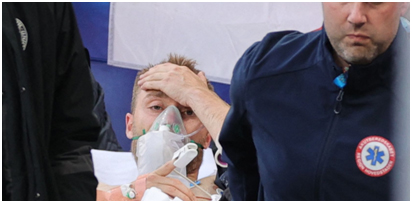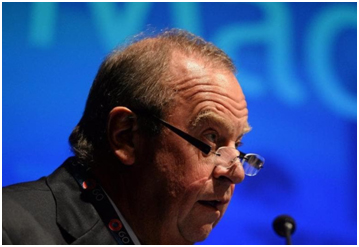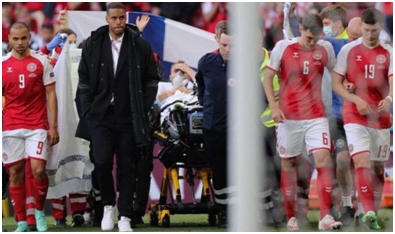How has Christian Eriksen’s collapse increased the awareness about on-field medical checkups_quick medical aid
UEFA Euro Cup 2020: Christian Eriksen’s Collapse During The Match
It was June 12th, when football fans across the world were excitedly watching the match between Denmark and Finland, as part of the Euro Cup 2020. The match was into its 43rd minute when Denmark team midfielder Christian Eriksen collapsed on the pitch. Team members promptly rose to the occasion, rushing to roll him onto his side so that his airways were open. While the medical team attended to his condition, a number of his teammates in UEFA Euro 2020, in a conscientious move, formed a human wall around the scene. Eventually, it was assessed as a case of cardiac arrest.
What is SCA?
In the case of SCA (Sudden Cardiac Arrest), a person’s heart fails to pump blood effectively throughout the body. It depends on electrical impulses from the body’s pacemaker cells to develop a regular heartbeat. Blood is first pumped to the lungs where it is oxygenated and then the oxygen-rich blood is pumped to the rest of the body. One can suffer from a cardiac arrest due to several reasons, but it mostly occurs due to malfunctioning of the heart’s electrical system, which leads to irregular and ineffective heartbeats.
How Did the Medical Team Respond At Euro Cup Football?

It goes without saying that had it not been for the well-trained and well-equipped medical team that sprung in action that day, we probably would have lost the young and bright midfielder. The response team started chest compressions within minutes of his collapse. They also applied a defibrillator, a device that delivers an electric shock to the chest aiming to restore a normal heartbeat. According to the Heart and Stroke Foundation, timely application of a defibrillator can boost a patient’s survival chance by 75%.
The heroes who saved the day, Morten and Anders Boesen, work for FC Copenhagen, who own and play at Parken, along with a public and a private hospital. Morten is the team doctor, while Anders is the stadium doctor. Morten eventually stated in his statement to the media that they had optimal working conditions, thanks to the team that surrounded them, including physio Morten Skjoldager, the pitch-side doctor, the stretcher team, the paramedics the doping control officer, and the players of Euro football 2020 who made a circle around Eriksen.
The Experts’ Opinion on Ericksen’s Health Crises

According to Cathy Campbell, Assistant Professor of Family and Community Medicine and President-Elect of the Canadian Association of Sport and Exercise Medicine, she said ‘’it is a significant undertaking to be prepared to deal with different scenarios during a match. It is imperative for medical teams to be ready for anything at a moment’s notice’’.
She further added that knowing how to work a defibrillator is not enough, the whole team should be ready for action even after spending hours sitting watching matches. Keeping the medical team up for long days, weeks, and so forth is part of the job.
Campbell went on to assert that training should start weeks before the commencement of the tournament, and the medical team must get used to working with each other and learning all the big and small details of the pitch they are on. The UEFA medical guideline clearly states that medical teams on the pitch must have specialised medical equipment, including cardiac life saving drugs, within easy access. Be it a minor knee injury or a collapse on the field, the team should be in a position to deal with it. Campbell also devotes time to walking through the stands and behind-the-scenes areas, planning the bail-out options for every scenario- be it an evacuation if necessary or the identification of safe places for setting up medical equipment.
Speaking about Eriksen’s collapse amid the Euro 2020 match, Mary M. Newman, MS, Sudden Cardiac Arrest Foundation President, has also specified that currently, only one of 10 victims survive an out-of-hospital cardiac arrest. His life was saved only due to the immediate action by the team members and bystanders. There is a national non-profit organization called the Sudden Cardiac Arrest Foundation that works towards building awareness about sudden cardiac arrest and how bystanders can have a life with some simple actions. This foundation has an active network of survivors and survivor families who are committed to educating people about these life-saving techniques. AEDs (Automated External Defibrillator) are designed in a way that they can be used even without training. Any layperson can also take help from the instructions that these devices themselves provide.
A Well-Prepared Medical Team is The Need of the Hour

A sports medical team should not be confined to learning only how to respond, but also when to respond. There are specific league rules indicating when medical teams can attend to such emergencies. For example, it can be controversial to interrupt the game without being signalled on by the referee. However, some leagues such as FIFA, have revised these regulations so that medical teams can rush to a player’s rescue if he has collapsed without coming into contact with a player or the ball. The incident reminded football fans of other football players who collapsed on the field.
In an unfortunate incident, Marc-Vivien Foe died during the 2003 Federations Cup in France. In all likelihood, this happened due to a lack of awareness of the need for speedy care. This was reinforced by Sanjay Sharma, Professor of Cardiology at St. George’s, University of London, who, in his statement to BBC Sport in 2013, expressed shock at the treatment received on the field. In another interview, he also mentioned that resuscitation should start within a minute and a half of someone going down. This, coupled with the use of the defibrillator within 3 minutes, can give the player a 70% chance of staying alive. However, Foe had to wait for six minutes with his eyes rolled back before attempts were made to restart his heart.
A tragic day in the history of FIFA, Foe’s death unfurled a series of changes that were introduced to minimise the risk of cardiac arrest on the field. Jiri Dvorak, FIFA’s Chief Medical Officer, confirmed to BBC Sport that this episode sparked a definite shift in on-field medical awareness, which made things such as examinations of players before a competition, training of medical teams in CPR and using defibrillators, and having emergency plans, were made an integral part of the game.
The public should learn how to recognise SCA (Sudden Cardiac Arrest) and they can save a life with CPR and AEDs. By following the simple phrase of ‘Call-Push-Shock’, the bystander can remember to call 911, give CPR, and use an AED. Newman went on to say that the story of Mr. Eriksen is not as unusual as one might presume, and that many survivors have had a healthy track record with no known heart impairments. She stressed the importance of education and accessibility to AEDs wherever possible, including sports venues for kids and adults. As she puts it, SCA can strike anyone, anywhere, without warning.
Let’s hope due emphasis is given to on-field medical aid in sports, and no such incidents are repeated in the times to come.

